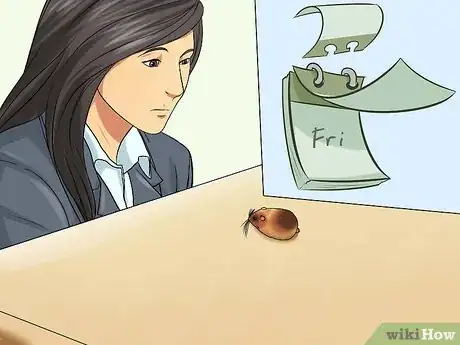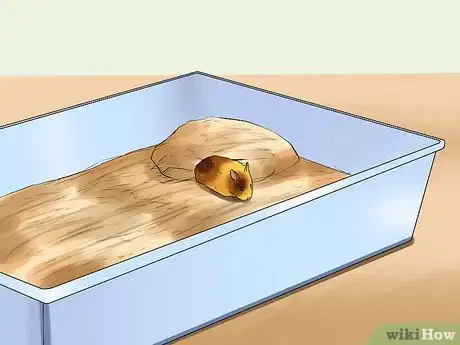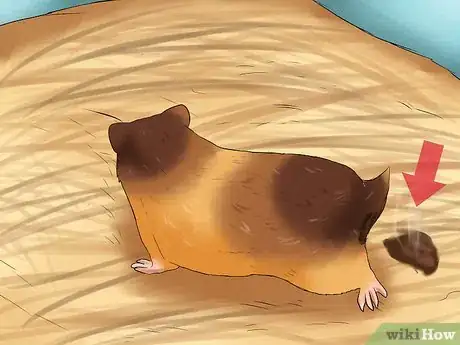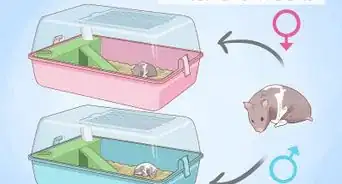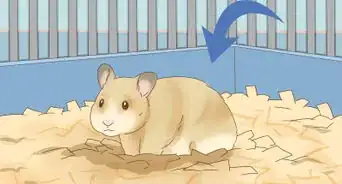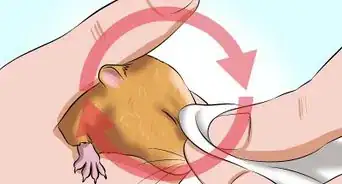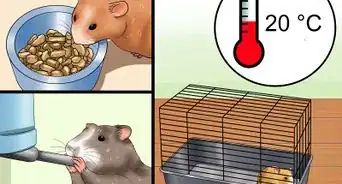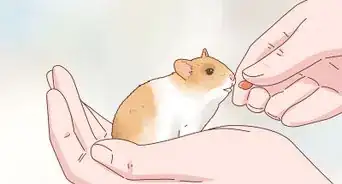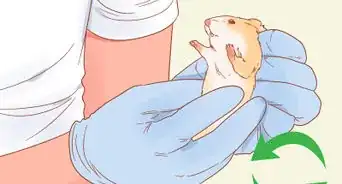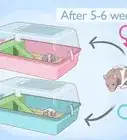This article was co-authored by Pippa Elliott, MRCVS. Dr. Elliott, BVMS, MRCVS is a veterinarian with over 30 years of experience in veterinary surgery and companion animal practice. She graduated from the University of Glasgow in 1987 with a degree in veterinary medicine and surgery. She has worked at the same animal clinic in her hometown for over 20 years.
wikiHow marks an article as reader-approved once it receives enough positive feedback. This article has 28 testimonials from our readers, earning it our reader-approved status.
This article has been viewed 433,259 times.
Paying close attention to your hamster’s health is an important part of being a responsible pet owner. Hamsters live for two to three years. Sometimes, when your hamster is old, there will be nothing you can do to save him. However, hamsters are also prone to a number of other serious illnesses that can be cured. You should always take your hamster to the veterinarian if you suspect your hamster is sick. The veterinarian will be able to tell you for sure what is happening with your hamster’s health.
Steps
Observing Your Hamster’s Behavior
-
1Spend time with your hamster every day. It is important to spend time with your hamster every day so that you know her normal behavior. A change in your hamster's behavior is an important indicator that she is sick. If you don’t spend time with your hamster regularly, you might not recognize important changes in your hamster’s behavior.[1]
- Get into a routine, so that you spend the same part of the day with your hamster. This will help you get accustomed to how the hamster is acting during the same period of time every day.
-
2Observe your hamster’s eating habits. A healthy hamster will eat regularly throughout the day. Although hamsters will sleep during the day, they will wake up frequently to eat.
- Be careful to note if your hamster is eating and how much he is eating.
- If your hamster is eating less, but still eating, keep very close watch over his eating over the next day or two.
- If your hamster stops eating altogether, you should take your hamster to the veterinarian right away.
Advertisement -
3Observe your hamster’s activity. Hamsters are normally very active, especially during the night. Your hamster will likely sleep during much of the day, so do not worry if your hamster sleeps a lot when the sun is out. If your hamster appears lethargic all the time and does not want to play, then she might be sick.
- If your hamster begins to act much less active and playful than in the past, pay close attention over the next couple of days.
- If the hamster’s activity levels do not return to normal, take your hamster to the veterinarian.
- Hamsters will naturally hibernate when the temperature stays cold for a long time. If you think your hamster is hibernating, indicated by what appears to be a very deep sleep and extremely shallow breath, warm up the area and make sure there is food and water on hand for when the hamster awakens.[2]
-
4Check for diarrhea. A common illness in hamsters is called “wet tail” and is accompanied by diarrhea. It can be evidence of a very serious infection.[3]
- Check the base of your hamster’s tail for a wet, mucus-like substance.
- If your hamster has diarrhea, accompanied by changes to eating and activity levels, it may be wet tail. Wet tail can be fatal within 48 hours. Therefore, you need to take action immediately and see the veterinarian.
- If the veterinarian finds a case of wet tail, he might prescribe antibiotics, anti-diarrheal, or give fluids.[4]
Observing Your Hamster’s Appearance
-
1Look at the hamster’s skin. Changes to your hamster’s skin can be indicative of health problems. In particular, look for signs of infection, like redness, swelling, and abscesses.
- Red, flakey skin can be a sign of an infection or of other skin diseases.
- Check for dehydration by lifting the loose skin (the scruff) over the hamster's shoulders. Let go and it should snap straight back into place — this is normal. If the hamster is dehydrated the skin "tents" or stays in a peak. This is a serious sign and you should get the hamster checked by a vet.
- Your hamster may scratch more when she has a skin problem. This can help tip you off to the fact that one exists. However, it can also cause infection if the hamster is picking at her skin. [5]
-
2Look at the hamster’s fur. Normally, a hamster’s fur should be full and shiny. As hamsters age, their fur will thin. This is normal. However, if your hamster starts to lose fur all at once, he might be sick.
- Wet, matted fur around the hamster’s belly and tail can be signs of an infection.[6]
-
3Look at the hamster’s face, mouth and eyes. In particular, look for a runny nose, red or inflamed eyes, and puffy cheeks.
- Hamsters often get a runny nose when sick, and are particularly vulnerable to catching colds. These are often not the most deadly of sicknesses, but if they persist, see a veterinarian.
- Your hamster has pouches in his cheeks to carry food around. If you notice that these pouches look full for a long time, it may be that they are infected.
Expert Q&A
Did you know you can get premium answers for this article?
Unlock premium answers by supporting wikiHow
-
QuestionWhy do hamsters die?
 Pippa Elliott, MRCVSDr. Elliott, BVMS, MRCVS is a veterinarian with over 30 years of experience in veterinary surgery and companion animal practice. She graduated from the University of Glasgow in 1987 with a degree in veterinary medicine and surgery. She has worked at the same animal clinic in her hometown for over 20 years.
Pippa Elliott, MRCVSDr. Elliott, BVMS, MRCVS is a veterinarian with over 30 years of experience in veterinary surgery and companion animal practice. She graduated from the University of Glasgow in 1987 with a degree in veterinary medicine and surgery. She has worked at the same animal clinic in her hometown for over 20 years.
Veterinarian
-
QuestionCan a hamster die from being too cold?
 Pippa Elliott, MRCVSDr. Elliott, BVMS, MRCVS is a veterinarian with over 30 years of experience in veterinary surgery and companion animal practice. She graduated from the University of Glasgow in 1987 with a degree in veterinary medicine and surgery. She has worked at the same animal clinic in her hometown for over 20 years.
Pippa Elliott, MRCVSDr. Elliott, BVMS, MRCVS is a veterinarian with over 30 years of experience in veterinary surgery and companion animal practice. She graduated from the University of Glasgow in 1987 with a degree in veterinary medicine and surgery. She has worked at the same animal clinic in her hometown for over 20 years.
Veterinarian
-
QuestionHow do you dispose of a dead hamster?
 Pippa Elliott, MRCVSDr. Elliott, BVMS, MRCVS is a veterinarian with over 30 years of experience in veterinary surgery and companion animal practice. She graduated from the University of Glasgow in 1987 with a degree in veterinary medicine and surgery. She has worked at the same animal clinic in her hometown for over 20 years.
Pippa Elliott, MRCVSDr. Elliott, BVMS, MRCVS is a veterinarian with over 30 years of experience in veterinary surgery and companion animal practice. She graduated from the University of Glasgow in 1987 with a degree in veterinary medicine and surgery. She has worked at the same animal clinic in her hometown for over 20 years.
Veterinarian
Warnings
- The vet might not be able to do anything for your hamster.⧼thumbs_response⧽
References
- ↑ http://www.merckvetmanual.com/pethealth/exotic_pets/hamsters/routine_health_care_of_hamsters.html
- ↑ http://www.askavetquestion.com/answer_np.php?id=576-is-hamster-hibernating-or-dead
- ↑ http://thehamsterhouse.com/hamster-illnesses/wet-tail/
- ↑ http://www.drsfostersmith.com/pic/article.cfm?articleid=2282
- ↑ http://exoticpets.about.com/cs/hamsters/a/hamsterhealth.htm
- ↑ http://www.merckvetmanual.com/pethealth/exotic_pets/hamsters/disorders_and_diseases_of_hamsters.html
About This Article
To know if your hamster is dying, keep a close eye on it to make sure it's eating every day and being active at night. If your hamster stops eating, or if it acts lethargic all day and all night, take it to a vet since it could be a sign that something is wrong. Also, if your hamster has diarrhea along with these symptoms, it could be a sign that it has a serious infection that can be fatal within 48 hours if left untreated. Make sure you take your hamster to the vet as soon as possible if you think something is wrong so it can receive the treatment it needs. To learn how to tell if your hamster is sick based off of its appearance, scroll down.
